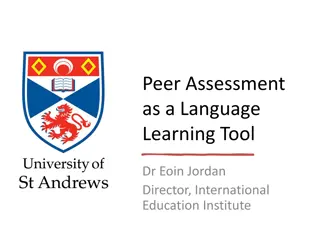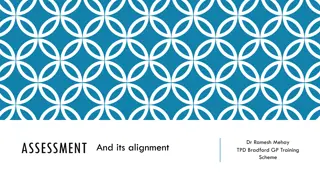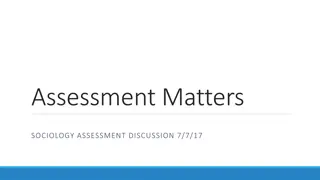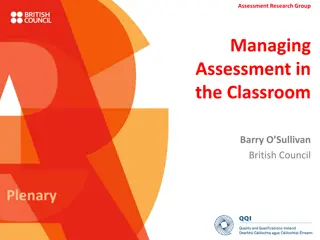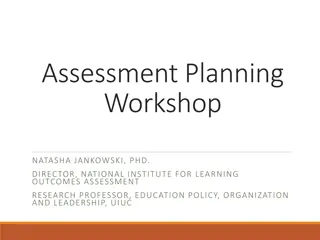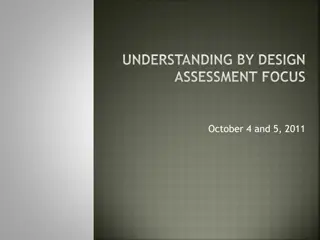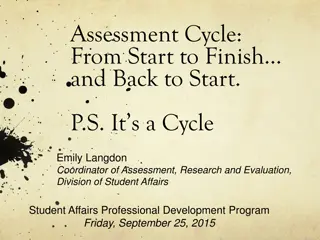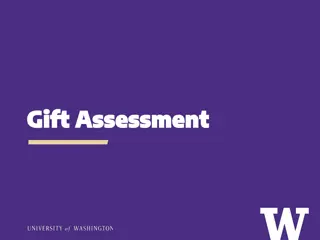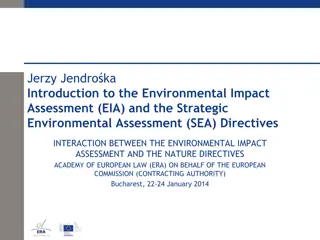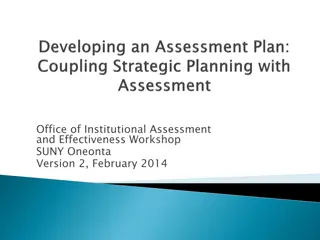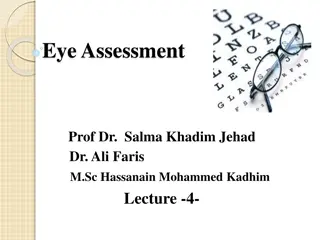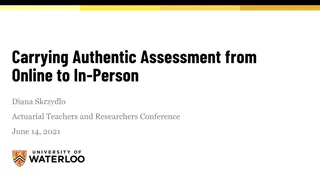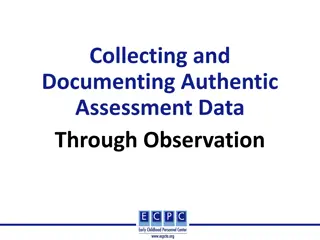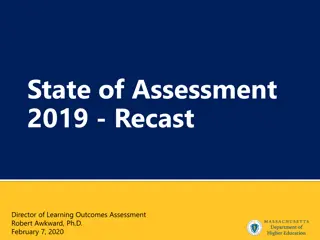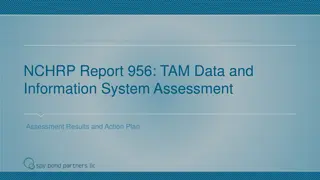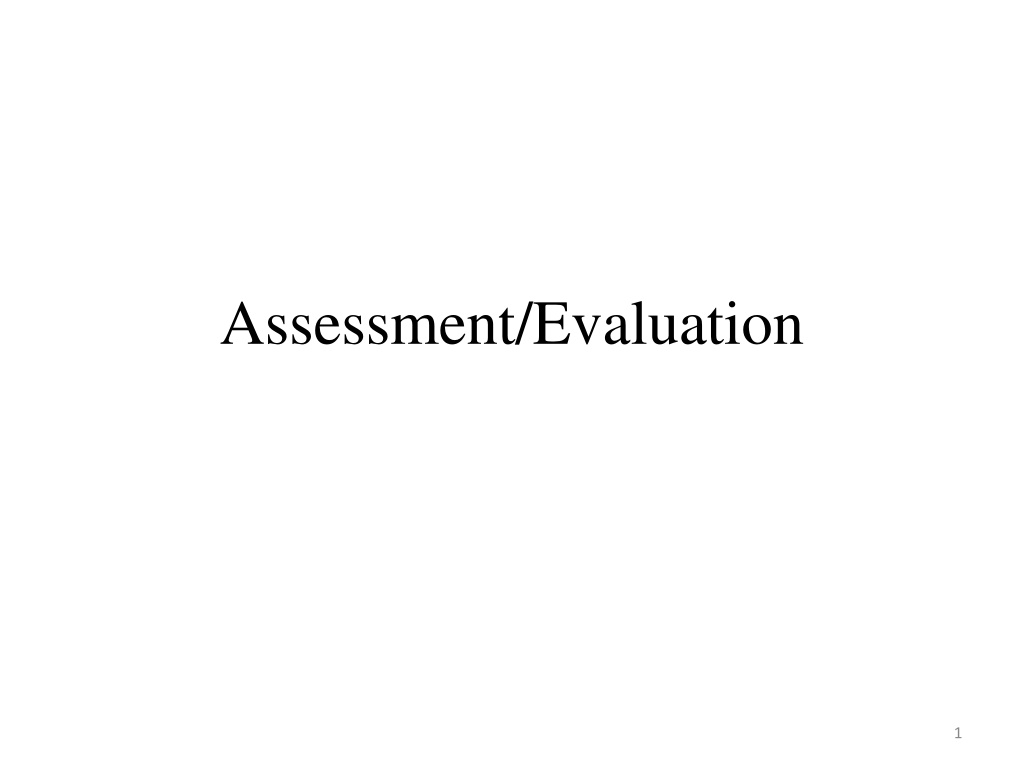
Importance of Educational Assessment and Evaluation in Student Learning
Discover the significance of assessment and evaluation in education, how they impact student learning, and the different types of assessments used in educational settings.
Download Presentation

Please find below an Image/Link to download the presentation.
The content on the website is provided AS IS for your information and personal use only. It may not be sold, licensed, or shared on other websites without obtaining consent from the author. Download presentation by click this link. If you encounter any issues during the download, it is possible that the publisher has removed the file from their server.
E N D
Presentation Transcript
Importance of evaluation and testing The primary purpose of test, measurement and evaluation is to improve student learning. Determines students strengths and weakness in achieving learning expectations. Guides teachers in adapting curriculum and instructional approaches to students needs. Assesses the overall effectiveness of programs and classroom practices.
EDUCATIONAL MEASUREMENT AND EVALUATION MEASRUMENT: Itsrefer to the process used to assign numbers to attributes or characteristics of persons, objects or events according to explicit formulations or rules. Is the process of obtaining numerical description on the degree to which an individual possesses a particular characteristics In general measurement answers the question on HOW MUCH
Measurement Teachers can measure attributes such as the heights of the students, the intelligence of the special class students, or The achievement of the pupils in different curricula. These examples are the characteristics of students that are being measured.
Assessment ASSESSMENT: is the systematic collection of data to monitor the success of a program or course in achieving intended learning outcomes (ILOs) for students. OR Assessment in education is the process of gathering, interpreting, recording, and usinginformation about pupils responses to an educational task. (Harlen, Gipps, Broadfoot, Nuttal,1992) Assessment is used to determine: What students have learned (outcome) The way they learned the material (process) Their approach to learning before, during, or after the program or course 5
Assessment You can assess students: Before instruction to get a baseline of what students know (for example, by administering a pretest). During instruction, assessment can be used to determine what students are learning so you can adjust your teaching, if needed. Quizzes or mud cards, which ask students to identify the muddiest point that remains for them after the class, are two methods of this kind of formative assessment. After instruction, you can use assessment for two purposes: (1) to determine if there has been a change in knowledge (final exams can be used for summative assessment ); and (2) to provide you with information to revise the class or program. 6
Types of Assessment Formative Assessment Summative Assessment Placement Assessment Diagnostic Assessment 7
Types of Assessment Formative Assessment Formative assessment: implies that the results will be used in the formation and revision process of an educational effort. Formative assessments are used in the improvement of educational programs. Summative Assessment Summative assessment is used for the purpose of documenting outcomes and judging value. It is used for providing feedback to instructors about the quality of a subject or program, reporting to stakeholders and granting agencies, producing reports for accreditation, and marketing the attributes of a subject or program 8
Types of Assessment Placement Assessment Usually done at the beginning of the class/course/ program Eg. Pre-test, Matriculation, Streaming Diagnostic Assessment Can be performed any time when there is persisting difficulties It is done for special learner when you found there is a problem Most of the time interview used to identify problems of the learner Teacher should use guidance and concelling 9
Formative The vast majority of genuine formative assessment is informal, with interactive and timely feedback and response. It is widely and empirically argued that formative assessment has the greatest impact on learning and achievement. 10
Formative assessment Assessment for learning Taken at varying intervals throughout a course to provide information and feedback that will help improve the quality of student learning the quality of the course itself 11
Key Elements of Formative Assessment 1. The identification by teachers & learners of learning goals, intentions or outcomes and criteria for achieving these. 2. Rich conversations between teachers & students that continually build and go deeper. 3. The provision of effective, timely feedback to enable students to advance their learning. 4. The active involvement of students in their own learning. 5. Teachers responding to identified learning needs and strengths by modifying their teaching approach(es). Black & Wiliam, 1998 12
Summative Assessment Assessment oflearning Generally taken by students at the end of a unit or semester to demonstrate the "sum" of what they have or have not learned. Summative assessment methods are the most traditional way of evaluating student work. "Good summative assessments--tests and other graded evaluations--must be demonstrably reliable, valid, and free of bias" (Angelo and Cross, 1993). 13
Placement evaluation Aims to determine pupils performance at the beginning of instruction Is concerned with the pupil s entry performance and typical focuses on questions such as; 14
Placement 1) Does the pupils posses the knowledge and skills needed to begin the planned instruction? 2) To what extent has the pupil already mastered the objectives of the planned instruction? 3) To what extent do the pupils interests, work habits and personality characteristics indicate that one mode of 15
Diagnostic evaluation Diagnostic evaluation designed for the identification of students whose learning or classroom behavior is being adversely affected by factors not directly related to instructional practices. The purpose of the diagnostic evaluation is to determine the cause of persisting Learning difficulties and to formulate a plan for remedial action
Factors Inhibiting (Hinder) Assessment A tendency for teachers to assess quantity and presentation of work rather than quality of learning. Greater attention given to marking and grading, much of it tending to lower self esteem of students, rather than providing advice for improvement. A strong emphasis on comparing students with each other, which demoralizes the less successful learners. 17
Assessment tools Quiz (Pop up quiz) Test Group work Project End of semester Exam/Term Checklist Rating scale Interview guide Rubric 18
Assessment criteria Assessment criteria are crucial in establishing a clear understanding between teacher and students about what is expected from assessed work. They should specify clearly the standards that must be met and what evidence will be used to show achievement of learning outcomes. They help teacher to ensure consistency in the ways that they assess specific pieces of work and provide students with a clear sense of why they have received certain marks for their work and what they need to do to improve. They should be shared with students and, where necessary, explained to them. Many students do not feel confident or able to interpret assessment criteria on there own and often the grading process can seem very mysterious. Clear and specific assessment criteria can be extremely effective in helping students improve their performance and to feel confident in their learning. 19
Effective Criteria Good assessment criteria should always: describe which aspects of the learning outcomes will be assessed indicate what is needed for a pass using positive language state clearly what is expected to reach different levels of achievement cover all aspects the module but not too many to be unmanageable for students or teacher 20
K-6 Student Assessment 2005-2006 Type of Grade Assessment Timeframe Other Level(s) Tool Assessment *Observational Survey End of Kindergarten Year Results given to principals Kindergarten Summative *Guided Reading Levels *Writing Sample *Pre Tests *Post Tests Dec./Jan, March, May/June April - June Throughout Year Throughout Year Results given to principals * * * K- 4 K- 6 Formative Summative Formative Summative *District Wide Math Assessment To be determined To be determined To be determined Administered to new and/or low achieving students * *Benchmarks Formative Throughout Year 1st - 6th *Writing Prompt Summative January - March (TBD) 22
TEST Is an instrument or systematic procedure for measuring a sample behavior OR Tests are systematic procedures for observing persons and describing them with either a numerical scale or a category system. Thus tests may give either qualitative or quantitative information (Nitko, 1983). Usually test answers the question of HOW MUCH THE INDIVIDUAL PERFORM , either in comparison with others or in comparison with a domain of performance tasks.
Type of tests Teacher made tests: constructed by teachers for use within their own classroom. Standardized tests: Constructed by test specialists working with curriculum experts and teachers.
Type of tests Criterion-referenced tests (CRTs): relate a student s score on an achievement Test to a domain of knowledge rather than to another student s score. Norm-referenced tests (NRTs): designed to measure individuals differences in achievement, intelligence, interests, attitudes, or personality.
Type of tests Individuals tests: Designed to administer one parson at a time These tests are normally given orally and require examiner s constant attention Group tests: Canbe given to many persons at a time Less complicated than individual tests
Type of tests paper- and -pencil tests are almost always given to groups Objective tests: those tests that have clear and unambiguous scoringcriteria, that is, independent scores can agree on the number of points answers should receive. Subjective tests: have vague scoring criteria
Type of tests Power tests: Have generous time limits so that most students will be able to attempt every item Items are arranged from easiest to most difficult; last few items are normally so difficulty that no one is expected to get perfect score.
Type of tests Speed tests: Have severe time limits, but the items are so easy that few students are expected to make errors. The severity of time limits make it almost improbable for any students to finish all items.
Types of test Intelligence test: commonly refers to a person s general potential to solve problems, adapt to changing circumstances, think abstractly, and profit from experience, independent of prior learning
Writing Test Items Multiple Choice True or False Matching Type Restricted response Item or completion Test Essay Problem Solving Item Interpreting Item 31
Characteristics Of A Good Test Reliable Valid Usable Objectivity 32
Moderation What is moderation? Moderation is a quality assurance process that ensures appropriate standards. It is a process for ensuring that marks or grades are awarded appropriately and consistently. Moderation involves checking and reviewing assessment schemes, items and assessor judgments. is essentially a form of feedback to markers to help them align their marking standards with those of other markers. 33
What influences successful moderation of grades? The amount of effort required depends on factors, such as the degree of subjectivity, variability in student work, the amount of inconsistency that can be tolerated, marker numbers, past experience of markers, and the time and cost that can be afforded. Moderation of grades is most successful when: it is collaborative; involves open and transparent communication among assessors; provides constructive feedback and professional support. 34
Standardization of Exam Marks Standardization is a procedure whereby the raw scores of a single examination are transformed to have a desired mean and standard deviation In some courses the marks for assessment items may be standardized to ensure a fair translation between marks and grades. In these subjects, for each assessment the raw mark are standardized to a given mean and standard deviation. 35
Standardize Formula Z score = mark mean/SD T score = 10Z+50 36


